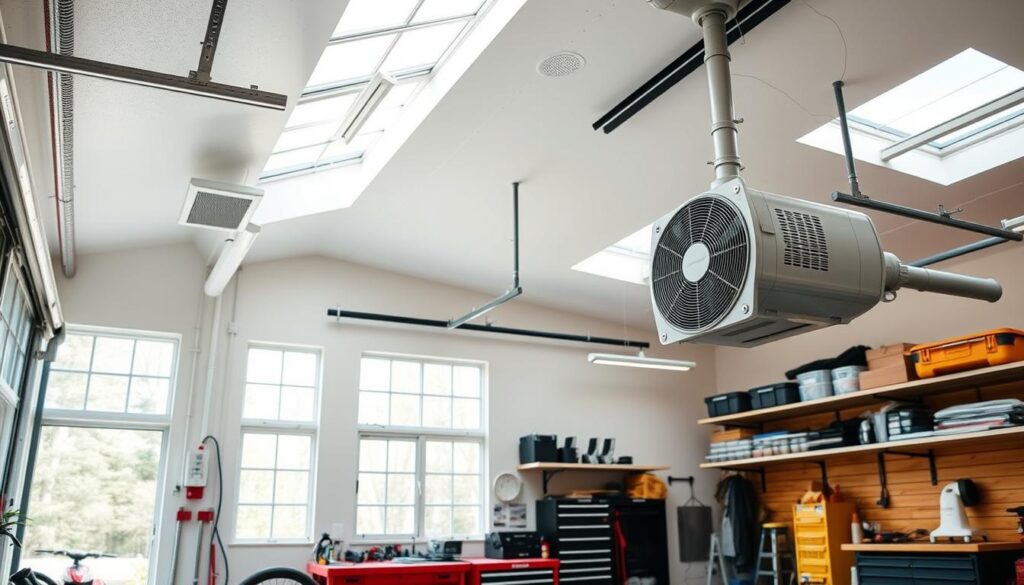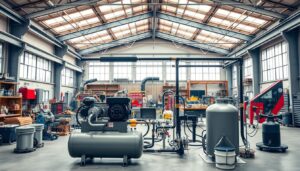Are you aware of the potential health risks associated with working in a poorly ventilated garage? Many homeowners are transforming their garages into functional workshops, but inadequate airflow can lead to a buildup of harmful fumes and particles.
Proper ventilation is crucial for maintaining a safe and healthy working environment. In this guide, we will explore the common challenges faced by UK homeowners, including seasonal temperature fluctuations and the accumulation of hazardous fumes from tools and materials.
By understanding the importance of air quality and implementing effective ventilation solutions, you can create a comfortable and safe workspace. This comprehensive guide will provide you with practical, cost-effective solutions to enhance airflow in your garage, regardless of its size or configuration.
Key Takeaways
- Understand the health risks associated with poor ventilation in garage workshops.
- Identify common challenges faced by UK homeowners in maintaining adequate airflow.
- Discover practical solutions to improve air circulation in your garage.
- Learn how to assess your specific ventilation needs and implement effective solutions.
- Explore cost-effective ventilation systems for a safe and comfortable working environment.
Why Your Garage Workshop Needs Proper Ventilation
Garage ventilation is often overlooked, but it’s vital for a safe and comfortable working environment. Your garage is likely used for more than just parking your car; it’s a workshop, a DIY hub, or perhaps a storage area for various appliances and chemicals.
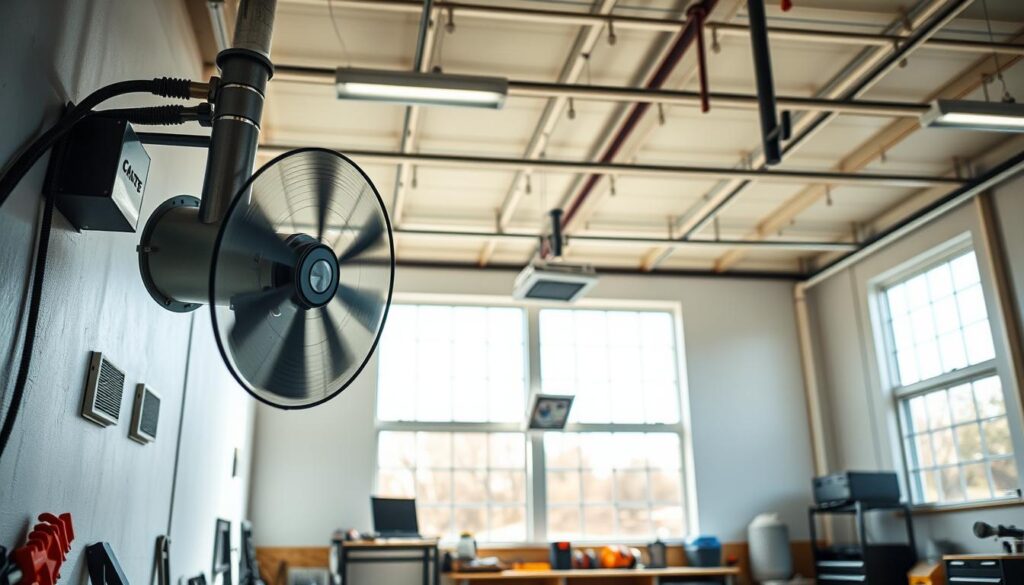
Health and Safety Concerns
Proper ventilation in your garage workshop is crucial for your health and safety. Without it, harmful fumes from paints, solvents, and other chemicals can accumulate, potentially causing respiratory issues over time. Ensuring good air quality protects you and your family from these hazards.
Protecting Your Tools and Equipment
A well-ventilated garage helps maintain stable environmental conditions, which is beneficial for your valuable tools and equipment. Excessive moisture and temperature fluctuations can lead to rust, corrosion, and premature deterioration. By maintaining good ventilation, you can extend the lifespan of your tools and keep them in good working order.
Creating a Comfortable Working Environment
A well-ventilated workshop creates a more pleasant atmosphere, allowing you to work comfortably for longer periods. Proper air circulation helps regulate temperature and humidity levels, making your workshop usable year-round, regardless of external weather conditions. This enhances your overall working experience and productivity.
The Risks of Poor Ventilation in Your Workshop
Poor ventilation in your garage workshop poses significant health and safety risks. Without proper airflow, harmful pollutants and moisture can accumulate, creating a hazardous environment.
Harmful Fumes and Chemical Exposure
In an enclosed garage workshop, chemical fumes from paints, varnishes, and solvents can reach dangerous concentration levels without proper ventilation. Vehicle exhaust, if your garage doubles as car storage, contains carbon monoxide and other harmful gases that need to be effectively removed. Exposure to these fumes can cause headaches, dizziness, and long-term health issues.

Condensation and Moisture Problems
Poor ventilation creates ideal conditions for condensation to form, especially during winter months. This excess moisture can damage walls, ceilings, and stored items, while also creating slippery surfaces that pose safety hazards. As “The underlying cause of garage roof condensation is a difference in temperature between the inside and outside of the garage.”
Temperature Regulation Issues
Workshops with inadequate airflow often experience extreme temperature fluctuations, making them uncomfortably hot in summer and freezing in winter. These temperature regulation issues not only affect your comfort but can also impact the performance of temperature-sensitive tools and materials.
5 Effective Ways for Improving Garage Workshop Ventilation
Improving airflow in your garage workshop can significantly enhance your productivity and overall experience. To achieve this, consider implementing one or more of the following ventilation solutions.
1. Installing Windows and Utilising Natural Airflow
Installing windows in your garage workshop provides an immediate solution for improving natural airflow. Strategically placed openings on opposite walls create effective cross-ventilation patterns. If adding new windows isn’t feasible, consider upgrading existing ones to models that offer better opening capabilities.
2. Strategic Use of Doors for Cross Ventilation
Your garage door itself can be a powerful ventilation tool. Modern sectional doors can be partially opened at the top to allow hot air to escape while maintaining security. Alternatively, you can install a garage door with built-in ventilation panels. For workshops with side access doors, positioning them strategically opposite windows creates an effective cross-breeze.
3. Adding Vents and Airbricks
Passive ventilation solutions like airbricks, soffit vents, and roof vents provide continuous airflow without requiring electricity. These are ideal for maintaining baseline ventilation levels. For example, breather vents are designed for flat roofs to improve airflow and reduce moisture build-up.
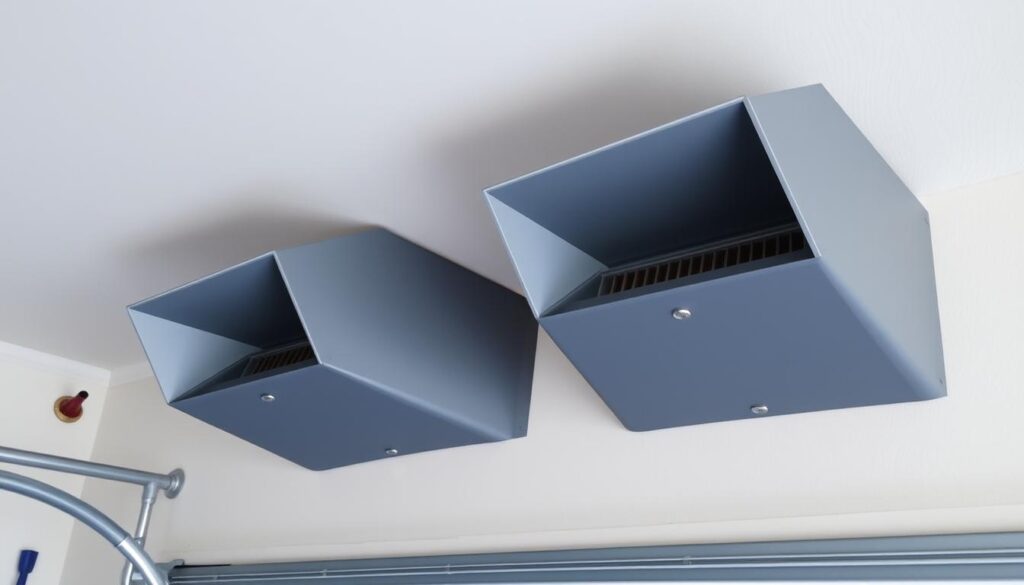
4. Using Fans for Active Air Circulation
Wall-mounted or ceiling fans significantly enhance air movement within your workshop space. Extractor fans are particularly effective at removing contaminated air directly to the outside. These fans are even more effective when used in conjunction with an open window or garage door.
5. HVAC Solutions for Year-Round Comfort
For year-round comfort in workshops used frequently, HVAC solutions like split air conditioning systems or dedicated heating and cooling units provide precise temperature control while filtering the air. These systems ensure a consistent and comfortable working environment regardless of the outside weather.
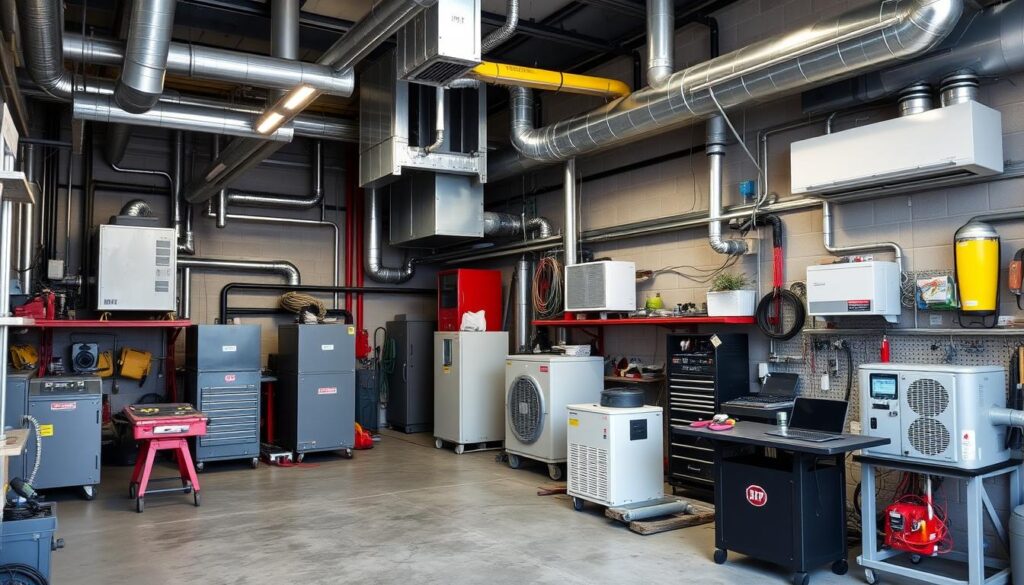
When selecting ventilation solutions, consider combining multiple approaches for the most effective results. This might include using passive vents for continuous background ventilation supplemented by fans for periods of intensive work.
Choosing the Right Ventilation Solution for Your Needs
When it comes to ventilation in your garage, one size doesn’t fit all; you need to pick a solution tailored to your workshop’s unique requirements.
Assessing Your Workshop Size and Layout
The size and layout of your workshop play a crucial role in determining the most effective ventilation solution. Larger spaces may require multiple ventilation points or more powerful systems to ensure adequate airflow throughout.
Considering Your Workshop Activities
The specific activities you perform in your workshop should guide your ventilation choices. For instance, woodworking generates different ventilation requirements compared to automotive work or painting projects. Prioritizing solutions that actively extract contaminated air is essential for workshops where chemicals, paints, or solvents are frequently used.
Balancing Cost and Effectiveness
Your budget will inevitably influence your ventilation options. However, it’s crucial to consider the long-term value rather than just upfront costs. Investing in proper ventilation now can prevent costly tool replacement and health issues later. Some ventilation solutions, such as strategically placed passive vents combined with portable fans, offer excellent value for money.
Maintaining Your Garage Workshop Ventilation System
To keep your garage workshop ventilation system running smoothly, regular maintenance is essential. A well-functioning system ensures good airflow and a safe working environment.
Regular Cleaning and Inspection
Regular cleaning and inspection of your garage ventilation system are crucial for its effectiveness. Dust and debris can accumulate in vents, fans, and filters, restricting airflow and reducing efficiency. Establish a monthly cleaning routine for all ventilation components, paying special attention to fan blades and vent covers. Inspect moving parts like fan motors periodically for signs of wear or damage.
Seasonal Adjustments for Optimal Performance
Different seasons bring different ventilation challenges. In the summer, maximum air exchange is required to control temperature, while in winter, ventilation needs to balance fresh air with heat retention. Adjust your garage ventilation strategy seasonally by changing fan speeds or modifying window positions. Consider how your insulation works in conjunction with your ventilation system to maintain optimal workshop conditions year-round.
Conclusion: Breathe Easy in Your Workshop
A well-ventilated garage workshop is not just a matter of comfort, but a necessity for protecting your health and equipment. By implementing the strategies outlined in this guide, you can significantly enhance air quality and create a safer working environment.
To achieve proper ventilation, consider a combination of approaches tailored to your workshop’s size, activities, and local climate. Start with simple solutions like strategic window and door placement, and adjust as needed. Regular maintenance will ensure your ventilation system performs optimally throughout the year, providing fresh air and a healthier workspace.
Take action today to assess and improve your garage workshop’s ventilation, safeguarding your wellbeing and the longevity of your tools.
